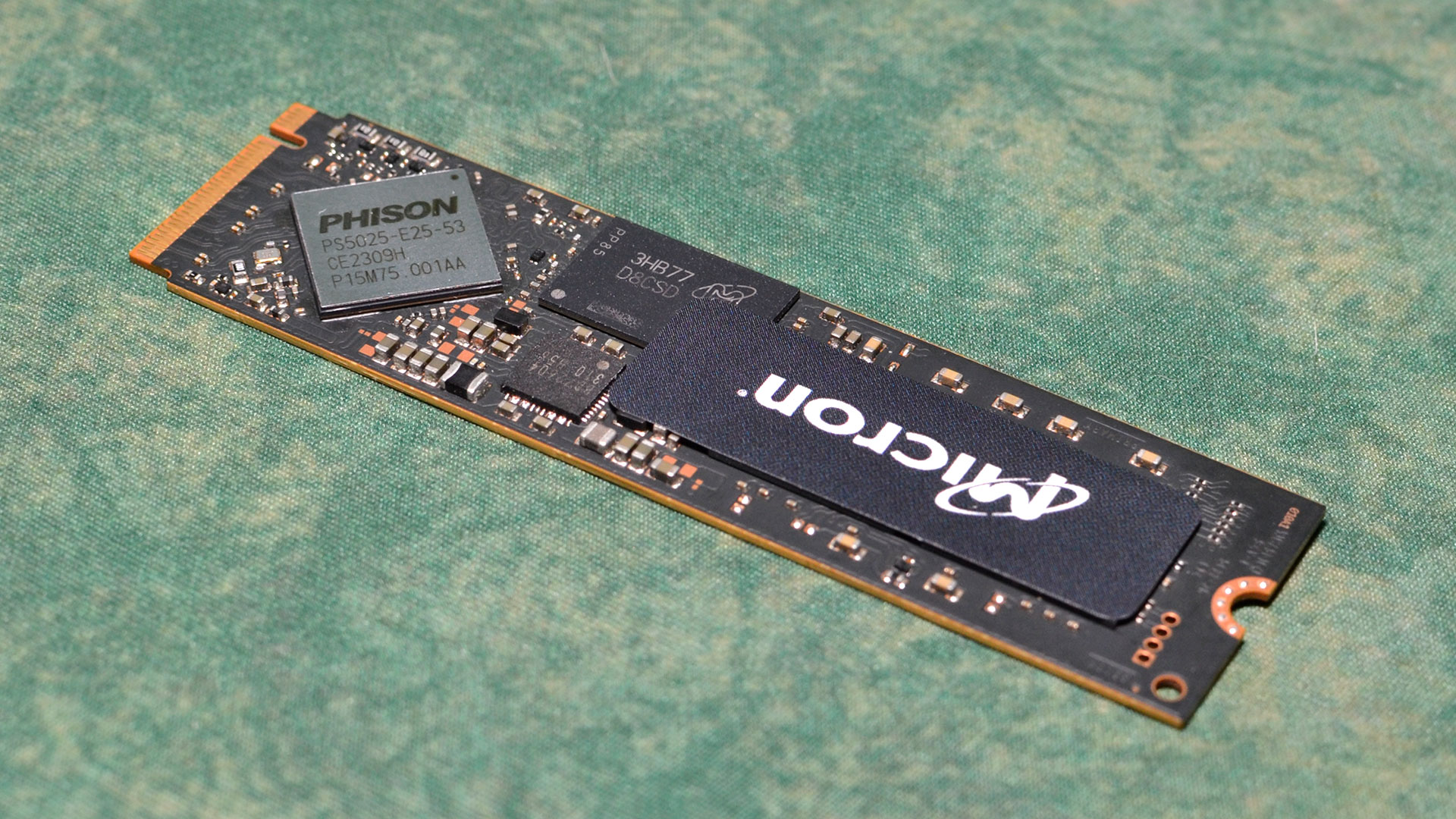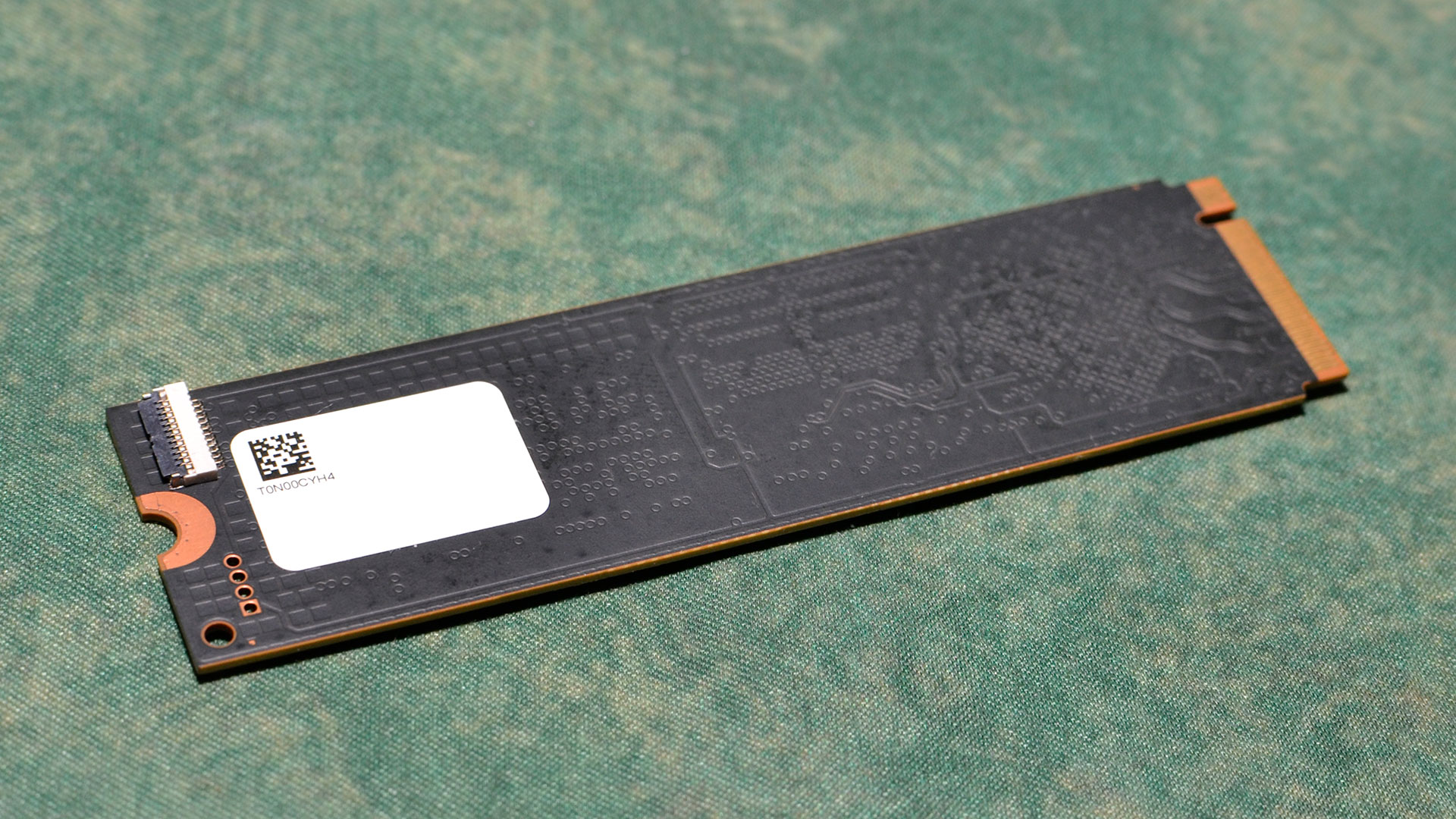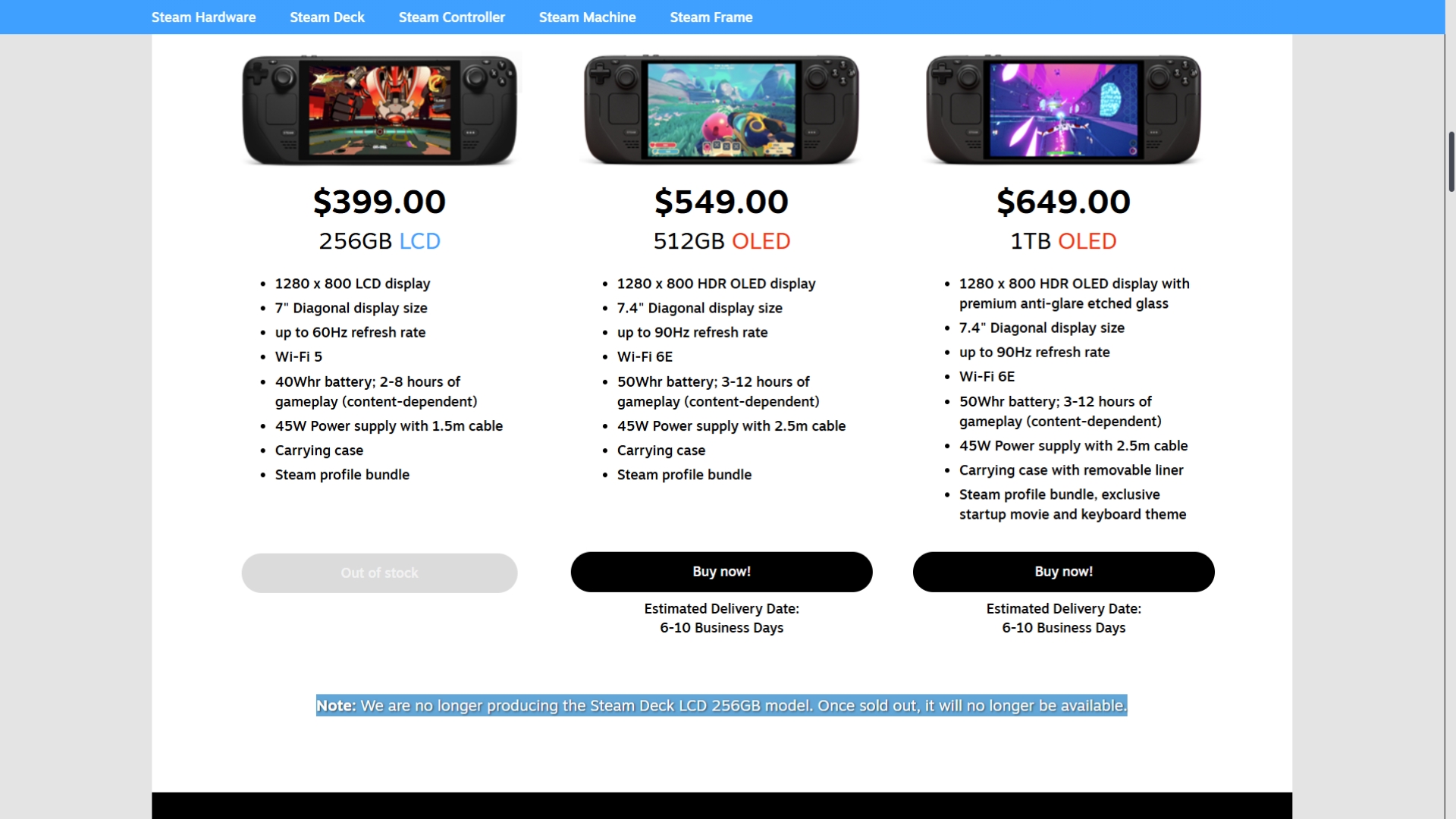Every once and a while, a great SSD comes around that hits all the right notes. It’s fast, it’s efficient, and it’s affordable. This was the case with Crucial’s excellent T500, which ranks among the best SSDs, and the technology didn’t go to waste as it’s destined to appear in pre-built, OEM machines in the guise of the Micron 3500 SSD.
So-called client drives have different objectives than off-the-shelf, retail models, as they can be tuned to specific OEM platforms and need to be reliable and consistent in a wide range of environments. That doesn’t mean they can’t be powerful in their own right, and the 3500 is packed with new hardware and DRAM to match in an echo of the popular SK hynix Gold P31, which had its own OEM analogue in the PC711.
We’re no strangers to OEM drives, having reviewed the Kioxia XG8 last year. Kioxia sometimes uses its own controllers and at other times relies on Phison to provide, even if the controllers continue to use Kioxia branding. Kioxia has also relied on Marvell in the past, and there’s reason to believe InnoGrit is behind the XG8. Kioxia’s OEM drives are often very popular, and its BG5 was commonly rebranded for use in the Steam Deck, a prominent example being the Inland TN436.
Crucial is in the same boat, having used proprietary controllers in its P5 and P5 Plus with technology from Tidal Systems that also went into the OEM 2300 and 3400 series. Crucial has used SMI and Phison controllers before, but the current impetus seems to be away from in-house and toward Phison. InnoGrit, like Phison, develops for enterprise and often cuts down its designs for client use, so it’s also an option.
This has obvious advantages and Crucial appears to have received a tailored E25 controller for its T500 and the Micron 3500 SSD counterpart we’re looking at today. With the E18 being so popular, a streamlined version with better power efficiency seems like a no-brainer. The Gold P31 had a similar development path, coming in late on the PCIe 3.0 interface and dominating the competition, particularly for laptops. The T500 and 3500 take that same approach, with added PS5 support and DirectStorage optimizations. If your new laptop or PC arrives with a Micron 3500, you’re in good shape for upcoming games. The drive also performs well at 1TB, as explored below, emphasizing that the 2TB T500 was not a fluke.
Specifications
| Product | 512GB | 1TB | 2TB |
|---|---|---|---|
| Pricing | N/A | N/A | N/A |
| Form Factor | M.2 2280 (Single-Sided) | M.2 2280 (Single-Sided) | M.2 2280 (Single-Sided) |
| Interface / Protocol | x4 PCIe 4.0 / NVMe 2.0 | x4 PCIe 4.0 / NVMe 2.0 | x4 PCIe 4.0 / NVMe 2.0 |
| Controller | Phison E25 | Phison E25 | Phison E25 |
| DRAM | LPDDR4 | LPDDR4 | LPDDR4 |
| Flash Memory | 232-Layer Micron TLC (B58R) | 232-Layer Micron TLC (B58R) | 232-Layer Micron TLC (B58R) |
| Sequential Read | 7,000 MB/s | 7,000 MB/s | 7,000 MB/s |
| Sequential Write | 5,100 MB/s | 6,900 MB/s | 7,000 MB/s |
| Random Read | 680K | 1,050K | 1,150K |
| Random Write | 700K | 1,150K | 1,150K |
| Security | TCG Opal 2.01 (SED) | TCG Opal 2.01 (SED) | TCG Opal 2.01 (SED) |
| Endurance (TBW) | 300TB | 600TB | 1,200TB |
| Part Number | MTFDKBA512TGD | MTFDKBA1T0TGD | MTFDKBA2T0TGD |
| Warranty | 3-Year | 3-Year | 3-Year |
The Micron 3500 is available in 512GB, 1TB, and 2TB capacities, currently omitting the anticipated 4TB model that the Crucial T500 promises. The hardware is otherwise the same, and while the drive is warrantied for 600TB of writes per TB capacity, like the T500, it’s only covered for by a three-year warranty rather than five. Consequently, the drive writes per day (DWPD) value is higher.
The Micron 3500 does support TCG Opal, specifically 2.01 for the self-encrypting drive (SED) feature, and TCG Pyrite 2.02 for non-SED. An “A” at the end of the product string denotes non-SED while “5” denotes SED. The 3500 is capable of up to 7,000 / 7,000 MB/s for sequential reads and writes and 1,150K / 1,150K random read and write IOPS, which falls just short of the T500.
Client drives are inherently expected to be used in environments where reliability is a primary concern, so we would expect some firmware differences in this model. Crucial has a pretty reasonable revision system as the T500 and Micron 3500 are “P8” with “P2” for the P2, “P3” for the P1, “P4” for the P5, “P7” for the P5 Plus and its Micron 3400 variant, “P9” for the P3 and P3 Plus, and “PA” — where A is 10 in the hexadecimal system — for the T700.
Okay, so maybe that isn’t so clear, but it means the T500 and 3500 share the same firmware base and the revision string gives you an idea of where it’s placed within the product stack. The DRAM-equipped P1 was probably laid out before the DRAM-less P2, and likewise for the T500 and P3 Plus. Other values in the string can indicate the product segment, such as enterprise, or the specific OEM. It’s interesting to see that Micron is careful with timing its products and we expect to hear more at CES 2024.
In any case, the point here is that while the Micron 3400 and P5 Plus had the same performance specifications, the 3500 and T500 diverge a bit. We will investigate any possible performance changes, though unfortunately we have different capacities (1TB 3500 and 2TB T500). The 3500 also gives more storage to the user than the T500, as with the 3400 and P5 Plus, by going for less overprovisioning. In practice, this does not make any real difference for a drive of this caliber. Since the 3500 is a client drive intended for OEMs, you can inspect new systems you purchase — or drives in the secondary market — to see what you have. We recommend reading the 3500’s technical product specification for full information.
Software and Accessories
Micron provides downloads for its Storage Executive Software SSD toolbox, the command line interface (CLI), and firmware binaries. The toolbox provides system and drive information, including SMART, with the ability to update firmware, sanitize the drive, and change the reported drive capacity with GUI over-provisioning or “Flex Capacity.” Momentum Cache remains a feature where system memory can be dedicated to caching for a specific drive, but this is not recommended as it usually provides little benefit. The Storage Executive Software is available for both Windows and Linux.
The CLI is available for Windows, Linux, ARM systems, and VMware ESXi systems. This requires registration to download, but the msecli is also included with the Storage Executive Software. Micron provides an extremely detailed user guide for the CLI, or Storage Executive Command Line Interface, and the software is very powerful. If you intend to work with these or other Micron drives, we recommend reading through the 64-page guide for maximum functionality.
A Closer Look

The Micron 3500 looks a lot like the T500 at first glance. In fact, the main difference is on the other side of the drive. The top side does reveal a conspicuous power management integrated circuit (PMIC) that’s larger than the standard Phison fare. Power management is becoming more important as SSDs get faster, and this is especially true in the client space. The 3500 does have power loss protection for data-at-rest and also support for a power loss signal. This can provide a small amount of time for the SSD to halt operations, but it should not be confused with battery-backed, full data-in-flight power loss protection (PLP).
The Micron 3500 also has the same angled Phison E25 SSD controller as the T500. Angling the controller could be an aesthetic choice, but there are other reasons to do so. One would be to deal with thermal management as a lot of heat escapes through the M.2 connector. Angling could also improve the controller surface area for heat dissipation while being arranged for optimal space usage for other PCB components. This placement could also improve flexibility in the layout for better data flow or signaling. It does help the drive stand out.
The controller package is designed for heat dissipation, much like the E26. The older E18 uses a flip chip chip scale package (FCCSP) in a 12x12mm form factor. This has benefits over the older E12’s 16x16mm thin-profile fine-pitch ball grid array (TFBGA), and the Phison E16 lands in between those two and utilizes a heatsink or heatspreader TFBGA (HSTFBGA) — not to be confused with heat slug — package for improved thermal management. Phison’s E21T, E27T, E25, and E26 all use a heatsink version of FCCSP (HSFCCSP) for similar reasons. This can result in a thicker package, but the drive meets the M.2 2280-S3-M specification as a single-sided drive.
More power means more heat and as such heatsink integration can also improve reliability. The Maxio MAP1602 SSD controller, as used in the popular Lexar NM790, is built in 7.1x11mm TFBGA and is known to run very hot. The E25 does take up more space at 12.5×12.5mm, but it has a DRAM controller that makes it, in a fashion, a sibling to the four-channel E12C used on the Kioxia Exceria. It’s able to provide high levels of performance without serious thermal drawbacks and should provide a consistent, reliable experience. The Exceria is and has been a popular, reliable OEM drive, and Kioxia has used Phison controllers on multiple OEM products, so rest assured that Phison technology is up to the task.
We’ve already discussed a lot of the technological features of the Phison E25 SSD controller in our Crucial T500 review. The controller itself uses the newer 4KB error correction over the older E18 with a new generation of LDPC. This improves endurance and, in some cases, performance. The Micron 3500 supports 512e and not 4Kn for sector sizes, which is perfectly fine for client or consumer use — we would not recommend getting a bunch of these drives for server workloads. Also supported is host-controlled thermal management (HCTM), part of the NVMe specification This means that power states can be adjusted around temperature thresholds, which can be useful. We’ll discuss that more on the next page.

On the rear side, the 3500 includes a 12-pin connector for debugging and diagnostics. The connected pads are also on the T500, but that drive lacks the connector. There are also four holes on the drive toward the screw side that can also be used for debugging. With proper knowledge, a drive can be placed into a fail-safe or read-only mode (ROM), which can be used to retrieve data or flash the drive with the proper mass production tool (MPTool). The pins can also be used for JTAG to access firmware and low-level controller functions. Note that such use cases are not intended for end users.

Our 1TB Micron 3500 sample uses a DRAM chip labeled “D8CSD,” which matches the one on our 2TB Crucial T500. This is 16Gb/2GB of LPDDR4. 1TB drives are usually paired with 1GB of DRAM as that provides an optimal ratio of volatile memory to NAND flash, but that is not a strict requirement. Phison E26 drives often have twice the memory normally needed as well. DRAM largely gets used for metadata, particularly mapping, and having more can provide performance benefits in some cases. It might also be easier to use 2GB across SKUs.
Micron uses its 232-Layer TLC, or sixth generation 3D NAND flash, on the 3500. This flash has worked well on the T500 as well as E26 drives like the T700. It’s Toggle and ONFi 5.0 compliant, which is a fancy way of describing its NV-LPDDR4 I/O interface. In this case, the flash is capable of running at up to 2400 MT/s with notable improvements over the previous generation. The ONFi standard allows better control through data bus inversion (DBI). This reduces power consumption with current and signal direction control. ONFi also has better on-die termination (ODT) capabilities. These changes are driven by a need to reach higher speeds with better power efficiency.
The Micron 3500 itself fits into Micron’s OEM SSD product stack, acting as a successor to the P5 Plus-inspired 3400. This can be useful in seeing what lies in store for future drives under both the Crucial and Micron branding. The 3600, for example, will likely use the next generation of flash, which we expect to have a higher layer count in the 200s but similar otherwise for TLC. QLC is more of a question mark right now, but a jump up in die density would be expected, which would be interesting. For now, though, the 3500 is a formidable SSD in its own right.
MORE: Best Hard Drives
MORE: Best SSDs
MORE: How We Test HDDs And SSDs





